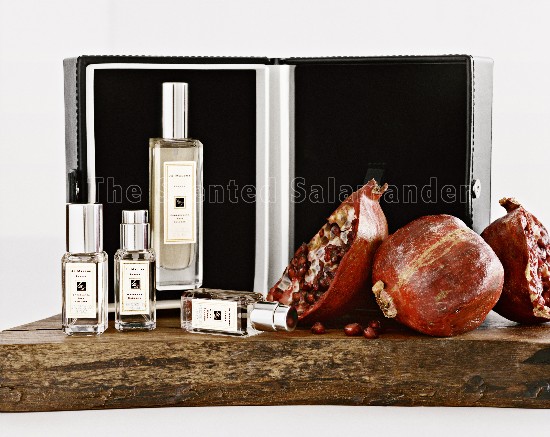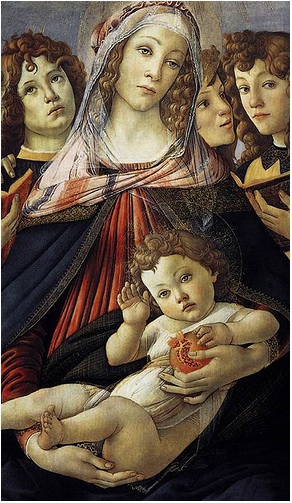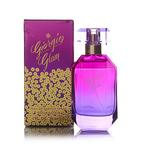Jo Malone Pomegranate Noir (2005) & Tasting Kit (2008) - Part 1 {Perfume Review}

Jo Malone is one of those perfume houses which are inspired by the concept of a fragrance-library in which new perfumes are added each time like carefully chosen tomes in a stately home library, hinting at the same time at the pleasure of the amateur botanist or entomologist meticulously collecting new specimens from the natural world (see Jo Malone Red Roses).
Pomegranate Noir, a fruit and a color this time rather than two main ingredients (it was considered a departure from the rest of the collection when it debuted), was launched in 2005 and was created under the artistic directorship of Jo Malone, the original British founder of the brand now owned by Estée Lauder companies. It came around a time when the designer admitted she was obsessed with color, confessing a new liking for garish orange daisies and a recently purchased red bodice.
The story of the perfume is that Malone was initially inspired by the sight of a red silk dress (see also for broader comparison Serge Lutens Rousse, a perfume similarly inspired by a red (velvet) dress).
The color that this scent evokes in fine is deep burgundy red or deep garnet red as streaks of black traverse the composition. It is one of the more abstract perfumes by the brand.
It reportedly took Malone two years to come up with a satisfying result, as she "...looked at thousands of submissions before solving the puzzle by adding spice notes to create the core pomegranate aroma...". She also explained at the time of its launch "I hate fruity fruity."
Officially, the scent includes notes of: raspberry, watermelon, rhubarb, plum, pink pepper, pomegranate, patchouli, frankincense and spicy woods.
Pomegranate Noir this fall and winter comes in a Tasting Kit as one of the interesting offerings of the holiday season and includes three other scents that rest on three main notes pulled out from the composition: Casablanca Lily, Raspberry and Guaiacwood (see our review in Part 2)...

Detail of the Madonna of the Pomegranate by Sandro Boticelli ca. 1487
Jo Malone Pomegranate Noir is a rather complex composition even if its style feels ultimately uncluttered and clean, not unlike the contrast of the polished outer shell of the fruit with its richer honeycombed and shimmering core.
The scent offers main facets of spices, fruits, woods, amber and leather. But there is also a host of secondary facets: green, salty, resinous, incense-y and hay-like notes. Focusing on its main accord, it smells of a dark and dry rendition of the pomegranate fruit thanks to salty, leathery, incense-y, amber-y and discreetly earthy patchouli nuances. The pomegranate accord's personality is true to nature beyond the stylized aspects of it. It is the scent of a pomegranate as the flavor releases in your mouth as then the arils burst open releasing their scent that was held captive before.
Pomegranate Noir - and herein lies its abstract character - relies much for its artistic cohesion on the recreated visual impact of the fruit, the eye's descent into saturated reds and obscurity (rather than transparent crystalline pinks as seen in some fruits). In this manner, the scent of pomegranate here becomes an imaginary journey into a dark, obscure well that smells a little bit of Dante's inferno, the delicate whiff of putrescence included. This is for its dark aspect. Pomegranate Noir also smells as if it had been tinctured from a pomegranate that would have been left abandoned in a washed up fisherman's boat by the defunct Aral sea. Traces of the smell of ancient dried fish and salty winds have brushed and penetrated the outer shell and somehow mummified its slightly tart and fruity aroma. This is for its dry aspect. The perfume offers a dessicated charm that goes beyond the usual potpourri feel of certain scents. It lures you in with its progressive darkening. It also evokes a sun and a heat that have turned black mimicking well, one realizes afterwards, the pagan myth of Proserpine descending to hell after having been made to eat pomegranate seeds. The Christian myth of suffering, death and resurrection symbolized by the bursting forth of the arils of the pomegranate, also linked to the pagan myth of Proserpine, is present in this fragrance which draws part of its spiritual suggestiveness from the inclusion of a note of dry frankincense.
But then later on the amber confers it a sort of renewed, hopeful olfactory rotundity and alludes to a fruitiness and fleshiness that is not so much juicy and dewy as made of warmth, glow, and light. After the impression of retreat from life and light, there is the sensation of a new life emerging. Younger tarter notes appear evoking the smells of freshly pressed pomegranates and also of its dark concentrated molasses. Taste is now sollicited after sight was stimulated.
The base of the scent in the far drydown is fresher than the middle part of it, even turning into a fougère or barber-shop accord over time, with its whiff of lavender, bringing a unisex-to-masculine touch and a fresh resolution to the perfume. Cedar and pine finally emerging add a forest-y feel to it the next day.
The perfume is clearly capable of great longevity without any external help such as sealing lotions.
Compared to another pomegranate perfume like Melograno Selvatico by I Profumi di Firenze, it offers much more consistently the dark atmosphere that can be associated with the scent's symbolism and the visual perception of it. This descent into obscurity and the path to light in the end can be experienced as a moral exercise just as well as being a pleasant aesthetic experience. Even the slight smell of dried fish that emanates from the scent easily evokes Christian symbolism, especially perhaps in this period of the year, which is also the season of the wintry pomegranate.
Next: our review of the Tasting Kit.
Source of the quotes: Elle Canada









